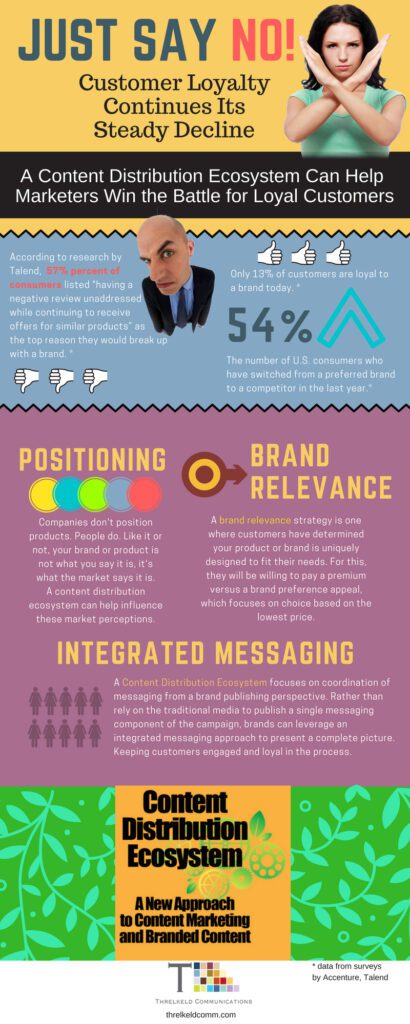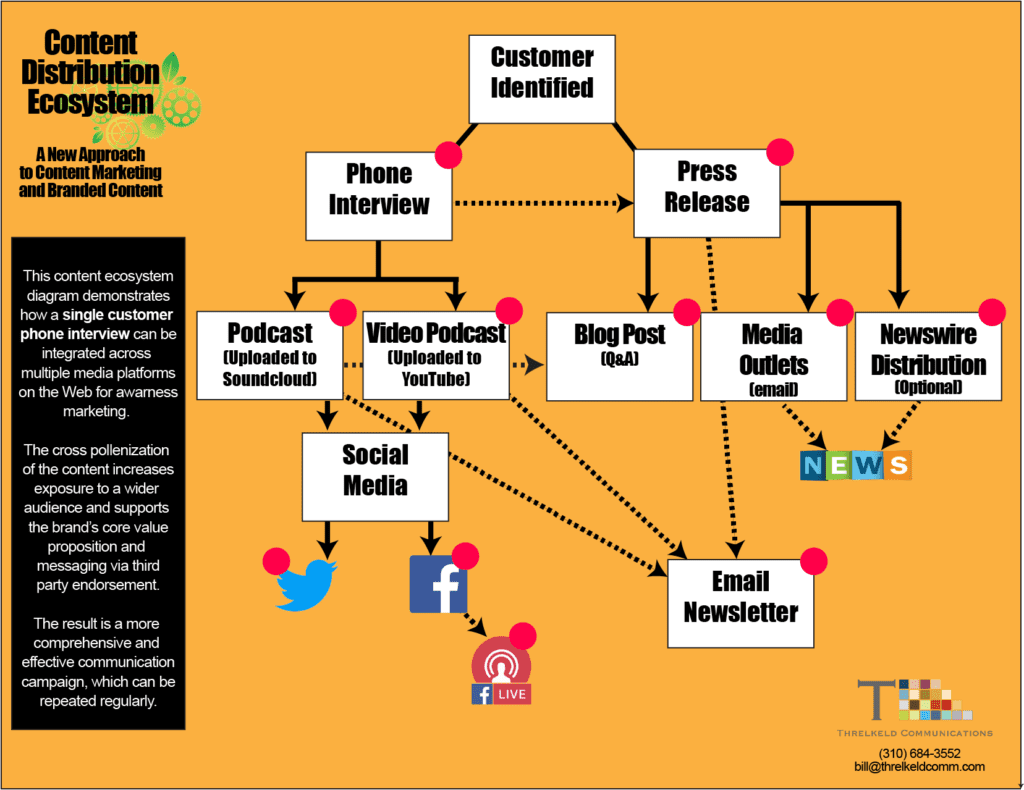Content Marketing in the Age of the Disloyal Customer

It’s no surprise that many traditional marketing efforts don’t work today. But what is surprising is how small the gap has become between what can be considered “traditional” versus “progressive” with regards to marketing efforts. In other words, at the pace of digital business today, traditional doesn’t refer to what we as marketers did five or 10 years ago. It’s what we did last year.
Zeroing in more on the challenge for marketers is what to do in today’s messy marketplace, including what approaches to throw away and what new ones to use. A premise of taking next steps with regards to change adaptation is to accept the fact that “new” does not necessarily mean “better.” And conversely that “old” does not necessarily mean “bad.” More about this later. Suffice for now to say that the core components of a strategic marketing plan, Advertising, Public Relations, Direct/eMail Marketing and Promotions, remain relevant and vital.
Content Marketing and Brand Relevance

The relevance challenge comes into sharp focus particularly as it relates to awareness marketing. Awareness marketing basically refers to the essential top-of-the-funnel strategies and tactics marketers must employ to keep the pipeline of new customers active. This need for high level awareness marketing and new customer prospecting is largely driven by the fact that, increasingly in 2017, consumers are becoming less and less loyal to brands.
Consider these 2017 statistics:
• 54% of U.S. consumers have switched providers in the past year (Accenture)
• Only 13% of customers are loyalists, those who don’t shop around (McKinsey Research)
• 57% of consumers listed “having a negative review unaddressed while continuing to receive offers for similar products†as the top reason they would break up with a brand (Talend)
The volatile mix of decreasing customer loyalty and increasing awareness marketing platforms (blogging, social media, internet broadcasting) is one that marketers cannot afford to ignore. This is because the potential for competitors to confuse and ultimately sway customers away from loyalty to a brand is greater than ever.
Thankfully, most marketers aren’t ignoring the signs and need to stay in front of customers. Research shows that content marketting budgets remain relatively healthy ad that awareness spending is continuing at a robust level. But, there is lots of evidence to support the premise that many marketers are going about addressing their awareness challenges the wrong way, resulting in confusion, frustration and wasted time and money.
Consider the old adage: “I know that half of the money I spend on advertising is wasted, I just don’t know which half.”

This brings us back to the topic of traditional marketing and its mixed blessing of effectiveness and defective-ness. Examples: I still see many companies drafting press releases and pushing these out via the newswire and email blasts. (This is traditional marketing as practiced 10 years ago.) I still get pounds and pounds of junk mail each week from credit card companies and banks (it goes straight into the shredder). A newspaper I used to subscribe to and canceled years ago still cold calls me regularly to try and get me to re-subscribe.
So what’s going on?
Content Marketing and the Content Distribution Ecosystem
It’s clear from the over-abundance of messaging and communications materials flying out that marketers recognize the need to stay relevant and visible. Consider this: a recent report showed that there are 2,000 new blogs posted every day. That same report referenced the fact that, to date in 2017, there have been 169,009 blogs published.
I subscribe to a leading industry blogger search database. Think Google for blogs specifically. I typed “Blood Pressure Monitor” into the Search box today and in less than three seconds, the search engine found 45,023 blog posts related to my query. The results ranged from the relevant (battlediabetes.com) to the curious (Laura and Amy’s Making a Baby Adventure at wegoforthesperm.wordpress.com).
With the wealth of information and communication media surrounding us, as marketers we are not in a battle for marketshare as much as a battle for mindshare. The principle of Positioning says that “companies don’t position products, people do.” If we want to gain marketshare, we must first gain mindshare (read this blog post). If we want to be preferred, we must first be seen as being relevant (read this blog post).
How do we do this? We circle back to the challenge of traditional versus contemporary when it comes to marketing. I believe the way to bridge the gap effectively is a hybrid of both approaches — traditional and contemporary. Press releases and blog posts can still be effective. But not as one-offs. These materials, and others such as social media posts, infographics, podcasts, videos, slide presentations etc. must be part of a coordinated brand communication effort.

I call this a Content Distribution Ecosystem (click on the image to the left to see an example of a campaign). This coordinated and integrated approach to content marketing recognizes the value of traditional marketing materials while leveraging the impact that a coordinated, integrated messaging distribution approach can have.
And the best part? Because the content distribution ecosystem campaign is built from a strategic messaging point of view, utilizing largely digital media to execute, results are measurable via Google Analytics, Facebook Pixel triggers, traditional media pickups, etc. And what we can measure, we can improve and build on.
The bottom line? To make a difference in your marketing efforts and to stand out above the clutter, you need to approach the process from a coordinated communications standpoint.
If you’d like to learn more about how a Content Ecosystem Distribution campaign can work for your brand or product, download this PDF overview showing how a connected content system can work efficiently to build awareness.
If you’d like to discuss positioning for your brand or product, please send me an email.

Bill Threlkeld is president of Threlkeld Communications, a content marketing and public relations agency based in Santa Monica, California. Threlkeld Communications specializes in integrated editorial ecosystem campaigns that utilize PR, Social Media, Blogs, Audio, Video and Email Marketing.
